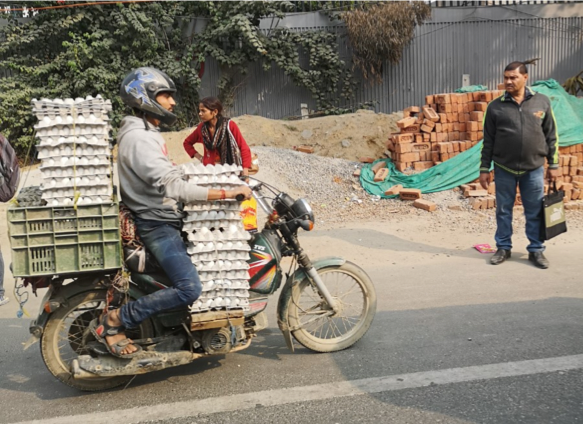by Mawer Investment Management, via The Art of Boring Blog
What’s the most important rule of risk management in investing? Well, if you asked Miguel de Cervantes, author of Don Quixote, he’d most likely say, “don’t put your eggs in one basket.”[1]

My colleague, Wen Quan Chong, snapped this photo while we were on a research trip in India last year.
[backc url='https://sendy.advisoranalyst.com/w/JYLmDqsFPB5F892UoC9DLyNw/g1892M8idNVuKzDuIVOSrnsQ/Ojy33NNShVjYmv763jkhZOnw']We have found that many Canadian investors—or any investor, for that matter—can be reluctant to diversify beyond their borders, but portfolios solely invested in Canada might as well be an egg crate on a rickety motorcycle. You might get where you want to go, but there will likely be a lot more risk during the journey. And, for many client situations, this means too much is riding on one bet—with not enough balance.
Canada has a narrow public market, largely driven by the natural resources sector and financial institutions that employ significant debt in their business models. In addition, after nearly a decade of low interest rates, Canadian consumers have amassed higher debt levels with a substantial amount of that capital having gone into real estate. Housing prices across our major cities are among the least affordable in the world on a price to income basis[2], which raises some concerns about the amount of debt there is to service should this egg crate wobble.
A fish doesn’t know it’s surrounded by water
David Foster Wallace has a perspective that I think applies to this situation:
There are these two young fish swimming along, and they happen to meet an older fish swimming the other way, who nods at them and says, "Morning, boys, how's the water?" And the two young fish swim on for a bit, and then eventually one of them looks over at the other and goes, "What the hell is water?"
Not to say that Canada isn’t a great country and an excellent place to invest. But sometimes, we become so accustomed to our environment that we become unaware of the bigger picture. A typical Canadian investor might not be aware of how domestically concentrated their portfolios are. A fish doesn’t know it is surrounded by water.
Many investors find solace investing most of their assets in their home country simply because it’s familiar. This “home bias” is a psychological issue and can lead to investment error.
Recall Iceland in 2008. At the time, the small island nation passed under most tourists’ radars. It was known mostly for its rugged terrain, active volcanoes, thermal springs, and its fishing industry. And, for being one of the first countries majorly damaged by the global economic crisis.
2008 saw Iceland’s three major banks default on $62 billion of foreign debt, which sent foreign investors scurrying, housing prices to crater, a quarter of home owners’ mortgages to default, the stock market to crash by 95%, and nearly every business across the country to go bankrupt. More than 50,000 people lost their savings—a sixth of the country’s entire population at the time.[3]
Imagine if you had had all of your nest eggs in that one Icelandic basket.
What to do? Be aware of the water and go global
Will Canada have an “Iceland moment,” complete with a real estate crash, banking failure, currency meltdown, and stock market collapse? It’s impossible to predict, but the probability of it happening isn’t zero. Low risk isn’t no risk.
This piece isn’t intended to forecast what will or won’t happen in Canada, however, our job is to think around corners when constructing resilient portfolios. To assess what could happen; identify if there are any sharp edges (i.e., too much concentration in a specific risk); gauge how the portfolio will bounce back; and determine if these are low or high probability scenarios.
Because Canada makes up just ~3% of the investible universe, our global strategies have a much bigger pool of companies to choose from that fit our investment criteria, providing more options within the portfolio to adjust if we need to.
So what’s an investor to do? A portfolio’s performance is comprised of both risk and return. Return is where you got to, risk is how you got there. For long-term investors, going global can reduce risk along the journey.
[1] “It is the part of a wise man to keep himself today for tomorrow, and not venture all his eggs in one basket.” Don Quixote
[2] More data from the OECD can be found here: https://data.oecd.org/price/housing-prices.htm
[3] https://www.economist.com/media/pdf/meltdown-iceland-boyes-e.pdf; https://www.thebalance.com/iceland-financial-crisis-bankruptcy-and-economy-3306347
This post was originally published at Mawer Investment Management













